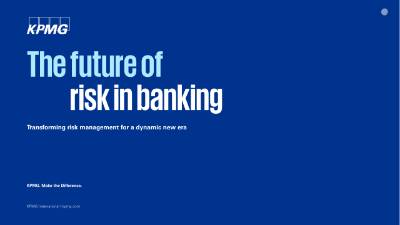In an era marked by constant disruption, the role of risk management in banking is evolving rapidly. To navigate this landscape, Chief Risk Officers (CROs) are no longer just compliance overseers; they are strategic guides steering organizations toward resilience and opportunity. Here’s a closer look into the forces shaping the future of risk in banking, as explored in KPMG's extensive research.
Key drivers of the evolving risk landscape
Several factors are reshaping risk management in banking
Emerging risks
Several interconnected factors are reshaping banks’ risk functions, including global fragmentation into trading blocs, geopolitical conflicts, and emerging technologies that present both risks and opportunities. KPMG's research highlights economic volatility and geopolitical complexity as the top challenges for banks.
Managing digital operations and digitalization
Digitalization is transforming banking services and controls, offering significant potential benefits but also exposing institutions to evolving risks like fraud, consumer protection issues, and system disruptions. To stay competitive, banks must balance innovation with effective risk management.
Meeting evolving regulations
Banks face diverse regulatory challenges, including compliance and ESG requirements, which vary by region and complicate adherence. KPMG's research identifies adapting to these evolving regulations as a key to transforming risk management, with compliance as a top strategy. While achieving compliance requires significant investment, AI and digital tools can lower costs. Banks' expertise in regulation gives them an advantage over fintech’s.
A roadmap to the future of risk management
Risk identification
Banks must implement mechanisms for rapid identification of emerging risks, assess their interdependencies, and use proactive, scenario-driven evaluations to address disruptive events effectively and safeguard operations.
Risk measurement
Dynamic risk assessment frameworks must combine qualitative and quantitative methods, implement cross-risk stress testing, and leverage integrated simulation tools for enterprise-wide evaluation of threats and opportunities.
Risk monitoring, control, and reporting
Advanced monitoring requires enterprise-wide collaboration, AI-driven solutions for efficiencies, and enhanced reporting systems that focus on actionable insights and alignment with regulatory demands.
Data and infrastructure
Effective risk management hinges on clean, integrated data from modernized systems, addressing legacy fragmentation and allowing scalable technologies like AI to unlock valuable insights critical for resilience and compliance.
Transform risk into opportunity
For risk leaders ready to embrace the future, this paper delivers some of the knowledge and tools necessary to help navigate today’s complex challenges. Explore how to turn risk into an opportunity for value creation and align your organization with the demands of the modern risk environment.
Reach out to us
Connect with us
- Find office locations kpmg.findOfficeLocations
- kpmg.emailUs
- Social media @ KPMG kpmg.socialMedia

